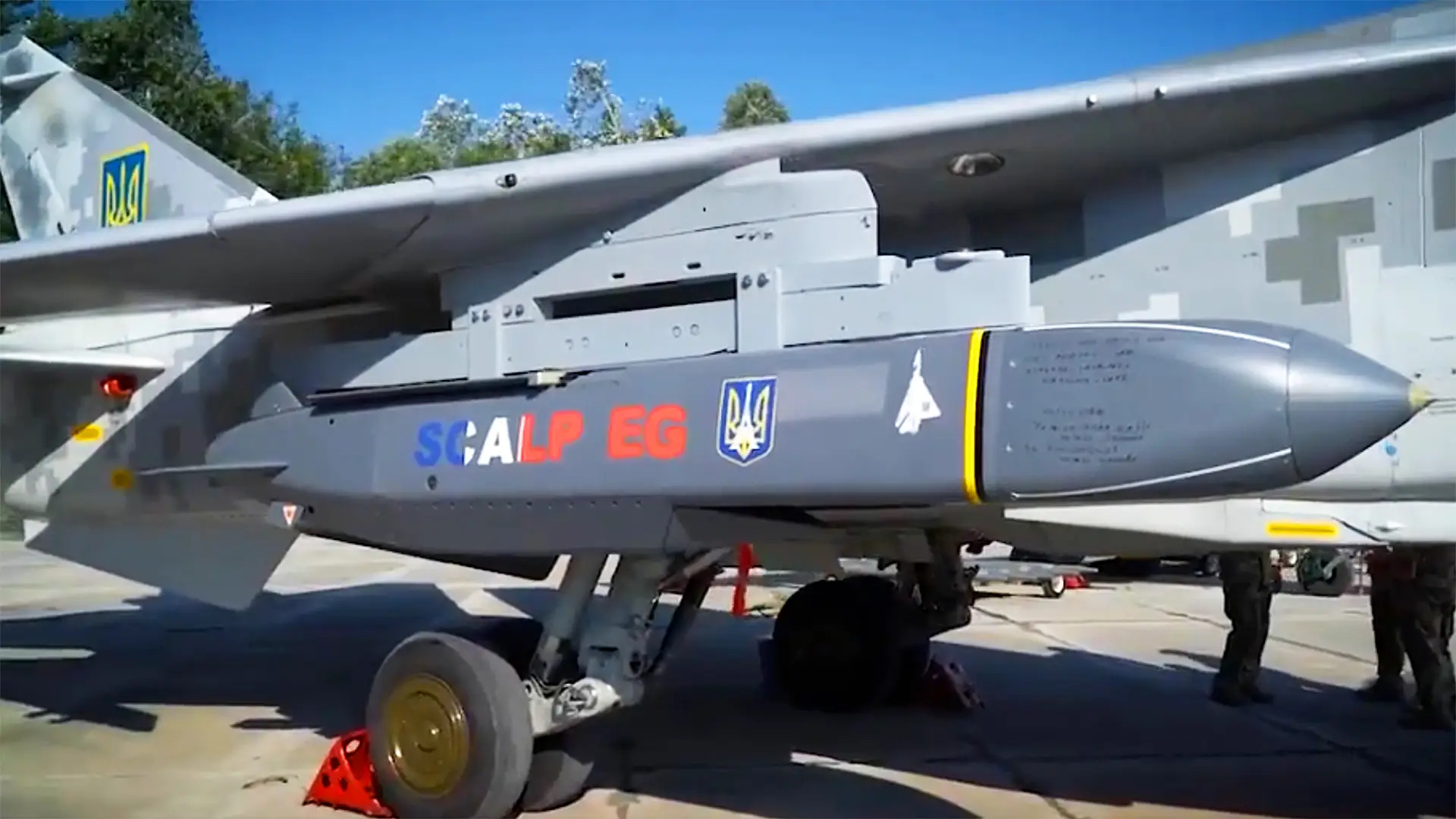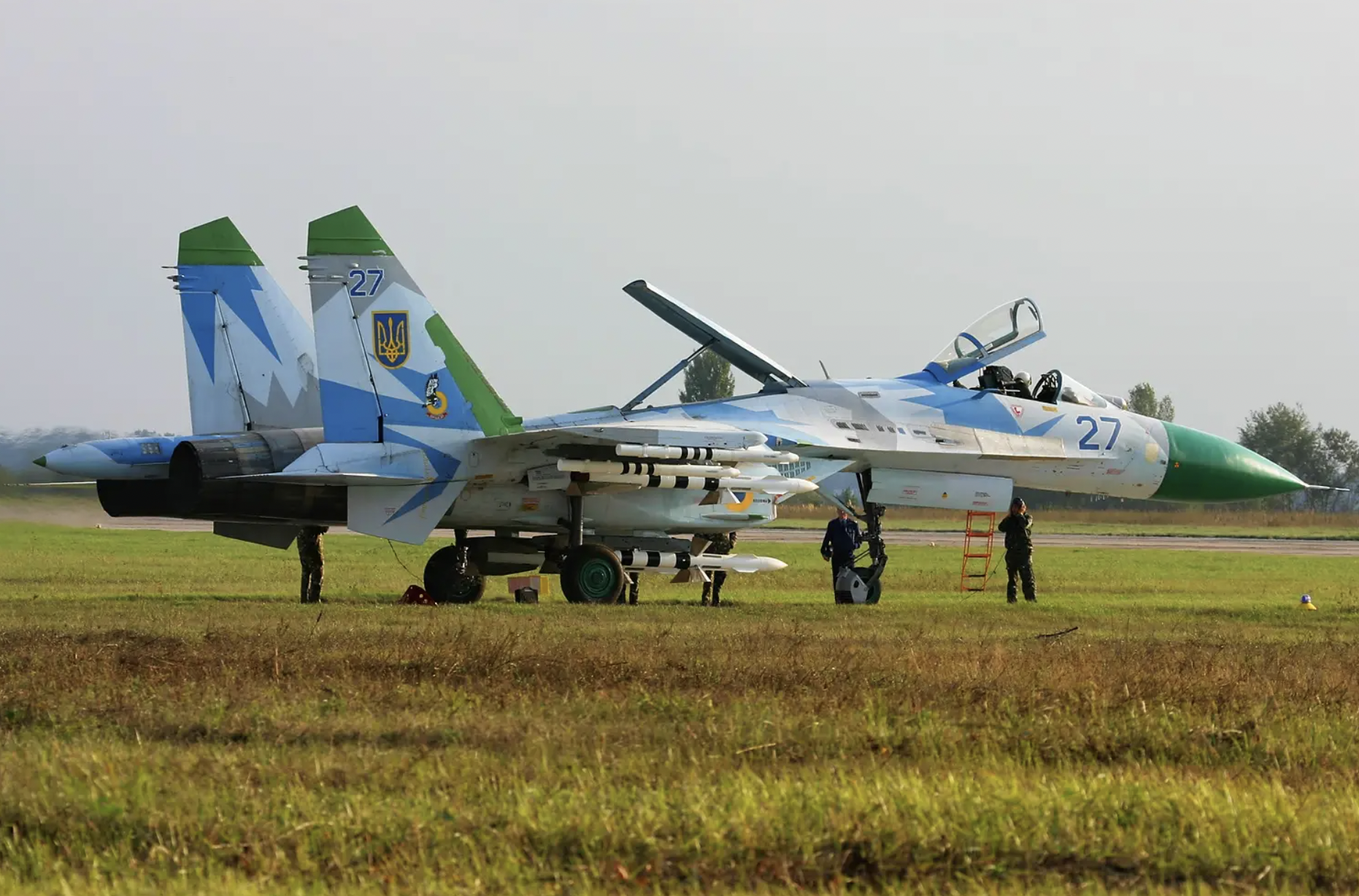Our best look so far at a winged JDAM-ER GPS-guided glide bomb in Ukrainian service also confirms that these weapons are being carried by Su-27 Flanker fighters, as well as the MiG-29 Fulcrums on which they have previously been seen. The photo of a JDAM-ER under the wing of a Ukrainian Air Force Su-27 also provides more details of the unique new pylon construction, apparently explicitly developed to allow these jets to haul these prized weapons, the full capabilities of which you can read more about here.
While the photo in question is undated, it was first posted to social media today, including by the Ukraine Air Force, to mark Ukrainian Independence Day, August 24. In the photo, Lt. Gen Mykola Oleshchuk, the commander of the Ukrainian Air Force, is seen signing the JDAM-ER, which appears to be based on a 500-pound Mk 82 bomb body. The text meanwhile reads “Death to Muscovites! For Ukraine! Commander of Air Force.”
Although only very few photos have previously emerged of the JDAM-ER in Ukrainian service, these had so far only shown the weapons carried by MiG-29s — numerically the most important Ukrainian Air Force fighter. The carriage of these glide bombs by the MiG-29 was first indicated by a photo that showed an unarmed Fulcrum with unusual inboard underwing weapons pylons, with tapered triangular protrusions forward of the bomb’s mounting point.
This pylon design can now be seen much more clearly in the photo of the Su-27 with Lt. Gen Oleshchuk.
The unfinished metal appearance of the pylon suggests this is a bespoke piece of equipment expressly designed to make the MiG-29 and Su-27 compatible with the JDAM-ER. Again, we can see part of the forward protrusion on the pylon, although its function remains unclear. You can read about some of the possibilities in our previous report.

As it stands, the fact that the Su-27 photo has been cropped in a way that conceals the forward end of the pylon may well signal that this is a sensitive area and one that Ukraine would rather keep hidden for operational security reasons.
While that cannot be confirmed, it could perhaps point to the pylon incorporating some kind of electronic support measures (ESM) or some kind of radar homing and warning receiver (RHWR), two possibilities we have considered in the past.
It’s important to remember that specially developed pylons have cropped up in Ukrainian Air Force service before, starting with the ad-hoc pylon for the carriage of the U.S.-supplied AGM-88 High-speed Anti-Radiation Missile (HARM), used for defense suppression. This weapon appeared first on the MiG-29, and then the Su-27, much in the same way as the JDAM-ER hardpoint.

Since then, Ukrainian Air Force Su-24M/MR Fencer strike/reconnaissance aircraft have also begun to use non-standard pylons. In this case, the jets use adapted pylons from now-retired RAF Tornado strike jets, to launch Storm Shadow and SCALP-EG cruise missiles — the longest-range weapons provided to Ukraine so far.

As for the JDAM-ER, there remain many questions about this weapon in Ukrainian hands. It’s unclear how many of Ukraine’s MiG-29s and Su-27s may have been modified to carry them, or how many of the bombs have even been delivered.
The first airstrikes using the winged bombs reportedly began in early March. Videos, like the one shown below, purported to show JDAM-ER strikes, but cannot be independently verified.
As we have discussed in detail before, the JDAM-ER is not a bomb itself, but a kit applied to an otherwise ‘dumb’ conventional bomb of the U.S.-made Mark 80 series. The bombs use inertial and GPS guidance to hit their static targets, making them true ‘fire and forget’ weapons.
Critically, in the JDAM-ER version, the kit includes pop-out wings, making it a standoff weapon with a range of dozens of miles, depending on the launch parameters.

Meanwhile, Russia is also making fairly extensive use of its own glide bombs, mainly launched from Su-34 Fullback strike fighters. Compared to the JDAM series, the Russian equivalents, or UMPK, are more crude and technologically primitive, but still have a pop-out wing and guidance kits and they have become a major concern for Ukraine, due to the problems in intercepting them.
Ukraine adapting the Su-27 to carry the JDAM-ER may be driven by the relative scarcity of suitable combat jets, at least compared to the Russian side.
On the other hand, using the Flanker as a JDAM-ER ‘shooter’ could offer some benefits, too.
As we have explained in the past, the Su-27 offers superior performance and range to the MiG-29, in certain key areas.
With its more powerful engines, the Su-27 can typically fly faster than the MiG-29, especially when loaded with weapons, and fly higher. Both these could be used to help ensure that the JDAM-ER’s standoff range is maximized, in turn helping the launch aircraft stay further away from ground-based air defense systems.

At the same time, the Su-27 offers a lot more range than the MiG-29, which would allow it to range much further from its base, which would be especially useful for striking Russian targets closer to the front lines.
Depending on how the JDAM-ER is actually employed, the option of loitering for a period of time, which the Su-27 would better allow, could also be very advantageous. That scenario, however, would only really come into its own if external data could be fed to the Su-27 pilot and that data could be uploaded to the JDAM while flying on the wing of the Flanker. That may be the case, especially if the peculiar pylons really are equipped with some kind of passive detection system that can geolocate air defenses.
Either way, the use of the Su-27 does suggest that the JDAM-ERs are being released at high altitudes, although it’s unclear how close to the front lines and at what level of risk. Provided the parameters exist for release from high altitude and at high speed, these weapons can travel for nearly 50 miles to hit targets near the front lines.

Finally, the Flanker series has long been lauded for the fact it can carry a large number of weapons. With the Su-27’s ability to carry over 9,500 pounds of external stores on 10 different hardpoints, it’s possible Ukraine’s Flankers could carry JDAM-ERs alongside multiple kinds of air-to-air weapons to provide self-defense.
However Ukraine is employing its JDAM-ERs, and whatever effect they are having on the battlefield, these advanced weapons also point the way to a different kind of air warfare that the Ukrainian Air Force is set to embrace in the future. After all, the experience gained using these precision-guided bombs, even integrated in an ad-hoc way with Soviet-era fighters, will be very useful once the air arm finally begins operating the F-16 jets that it now finally looks certain to receive.
Contact the author: thomas@thedrive.com
